Discover the simple steps to accurately measure your window screens, ensuring a perfect fit for optimal functionality and enhanced aesthetics.
Welcome to my blog where we talk about everything related to house windows. In today’s post, I want to share with you some useful tips on how to measure window screens.
Window screens are an essential part of any home as they provide protection against insects and other unwanted elements while allowing fresh air to flow into your living space. However, getting the right measurement for your window screen can be a daunting task, especially if you’re not familiar with the process.
But don’t worry! With this guide, you’ll learn how to measure your window screens accurately and efficiently. So let’s dive in!
Key takeaways:
- Fiberglass, aluminum, solar, pet-resistant, and retractable are common window screen types.
- Gather tools like a tape measure, pencil, paper, step ladder, and straight edge ruler.
- Identify screen type, frame material, clips, and screws for accurate measurements.
- Measure width at top, middle, and bottom; use the smallest measurement.
- Measure height from top to desired end point; consider obstructions.
Types of Window Screens

The most common types include:.
1. Fiberglass Window Screens: These are made from woven fiberglass and are durable, long-lasting, and resistant to rust.
2. Aluminum Window Screens: These are lightweight and sturdy but can be prone to denting or bending if not handled with care.
3. Solar Window Screens: They’re designed specifically for blocking out sunlight while still allowing airflow through your windows.
4. Pet-Resistant Screen Meshes: As the name suggests, these screen meshes have a thicker weave that makes them more resistant to damage caused by pets’ claws or paws.
5. Retractable Insect Screens – They offer an unobstructed view when retracted but provide protection against insects when extended.
Gather Required Tools

Having everything on hand will make the process smoother and more efficient. You don’t want to be halfway through measuring only to realize that you’re missing a crucial tool or piece of equipment.
The good news is that most of these tools are readily available in any hardware store or online marketplace. Here are some items you’ll need:
- Tape measure: This is an obvious one, but it’s worth mentioning as accurate measurements are critical.
- Pencil and paper: You’ll need something to record your measurements accurately.
- Step ladder: If your windows are high up, a step ladder will come in handy for reaching them safely.
- Straight edge ruler: A straight edge ruler can help ensure precise measurements by providing a straight line reference point when taking width and height dimensions.
Tools Needed for Measurement

Having the right tools will make the process more manageable and ensure accurate measurements. Here are some of the essential tools you’ll need:
1. Tape Measure: A tape measure is a must-have tool for measuring window screens accurately.
2. Pencil and Paper: You’ll need a pencil and paper to record your measurements as you go along.
3. Level: A level helps ensure that your screen frame is straight when taking measurements.
4. Square Ruler or Carpenter’s Square: This tool comes in handy when checking if corners are square or not.
5. Scissors or Utility Knife: You may need scissors or utility knife to trim excess screen material after installation.
Identify Screen Type

There are different types of window screens available in the market, and each has its unique features and measurement requirements. The most common types include standard fiberglass mesh screens, aluminum wire mesh screens, solar or sun-blocking window screens, pet-resistant insect screening material for households with pets or children.
To determine your screen type accurately:.
- Check if it is a fixed or removable screen.
- Look at the frame material; is it made from wood or metal?
- Determine if there are any clips holding the frame in place.
- Inspect whether there are any visible screws on either side of the frame.
Identifying your screen type will help you choose appropriate tools for measurement and ensure that you get accurate measurements that fit perfectly into your windows’ frames when ordering new ones.
Measuring the Width

To get started, you’ll need a measuring tape or ruler and a pen and paper to record your measurements. Begin by measuring the width of the frame from one side to another, making sure to measure at three different points: top, middle, and bottom.
Take note of each measurement as you go along.
If all three measurements are equal, then that’s great! You can use this measurement for ordering replacement screens or customizing new ones. However, if there are any discrepancies between these measurements (which is common), take note of the smallest measurement as it will be used for ordering purposes.
It’s important not to assume that all sides have identical dimensions since windows may shift over time due to settling foundations or other factors such as weather changes affecting their shape slightly.
Measuring the Height

To do this, place your tape measure at the top of the frame and extend it down to where you want your screen to end. Make sure that you’re measuring from one side of the frame to another in a straight line.
If there is an existing screen on your window, remove it before taking measurements for accuracy. If not removed properly or if left in place during measurement can lead to inaccurate results.
When measuring for height, be sure not only take into account any tracks or channels but also any obstructions such as handles or locks which may affect how high up on a track they sit when closed tightly against each other.
Record Frame Thickness

This measurement is crucial because it determines how deep your screen will sit in the window opening. To measure frame thickness, use a ruler or tape measure to determine the distance between the outer edge of one side of your screen frame and its inner edge.
It’s important to note that some screens may have different thicknesses on different sides due to manufacturing variations or damage over time. Be sure to take measurements from all four sides and record each measurement separately.
Recording accurate measurements for each aspect of your window screens ensures that you get a perfect fit when ordering replacement screens or installing new ones yourself.
Measuring the Depth of Screen Frame

This is an essential step in measuring your window screens accurately. The depth measurement will help determine if you need a standard or custom-sized screen.
To measure the depth of your window frame, use a tape measure and place it at one corner of the frame’s interior edge. Measure straight across to the opposite side’s interior edge while keeping it level with where you want to install your new screen.
It is important not to assume that all windows have standard depths as some may require custom sizing for optimal fit and functionality. Therefore, always double-check measurements before ordering replacement screens or installing new ones.
Note Corner Type

The corners are where the frame pieces meet, and they can be either square or mitered. Square corners are 90-degree angles while mitered corners have a diagonal cut at a 45-degree angle.
Knowing your corner type is crucial when ordering replacement screens as it determines how they will fit into your existing window frames. If you’re unsure about which corner type you have, take a picture or bring in one of your old screens to compare with new ones.
It’s also worth noting that some manufacturers offer custom-made screens with different types of corners than what is standard for most windows. So if you need an exact match for an older home or unique design feature, make sure to inquire about custom options before placing an order.
Double-Check Measurements

This step is crucial because even a slight error in measurement can lead to an ill-fitting screen that won’t function correctly. Double-checking your measurements will save you time and money by ensuring that the screen fits perfectly.
To double-check your measurements, compare them with the manufacturer’s specifications or consult with a professional if necessary. If there are any discrepancies between your measurement and their specifications, re-measure until you get accurate results.
Remember that taking accurate window screen measurements requires patience and attention to detail. Rushing through this process may result in incorrect dimensions leading to poorly fitting screens which can be frustrating for homeowners who want optimal functionality from their windows.
Tips for Accurate Measurements

Here are some tips to help you measure your window screens correctly:.
1. Use a metal tape measure: A metal tape measure is more reliable than a cloth or plastic one as it won’t stretch or bend.
2. Measure twice: Double-checking your measurements will ensure that they’re accurate and prevent any mistakes.
3. Record all measurements in inches: Most screen manufacturers use inches as their standard measurement unit; therefore, recording all dimensions in inches will make ordering replacement screens easier.
4. Measure from the inside of the frame: Measuring from inside ensures that you get an exact fit for your screen without leaving gaps between the frame and mesh material.
5. Take note of any obstructions on windowsill or frames such as locks, handles or cranks which may affect how far outwards/inwards (depth) the new screen should sit.
Proper Screen Sizing

A screen that is too small or too large will not fit properly and may compromise its effectiveness in keeping out insects and other unwanted elements. When ordering replacement screens, make sure to provide accurate measurements of the width, height, frame thickness, depth of screen frame as well as corner type.
It’s also important to note that some manufacturers offer standard sizes while others provide custom-made options. If you have unique window dimensions or shapes such as arched windows or circular windows with unusual angles – a custom-made option might be necessary.
Proper sizing is crucial when it comes to selecting new window screens for your home.
Ordering Replacement Screens

When ordering a new screen, it’s essential to provide accurate measurements to ensure that the screen fits perfectly into your window frame. Most manufacturers offer standard sizes for different types of windows; however, if you have an irregular-shaped or custom-sized window, you may need a customized screen.
When placing an order for replacement screens online or in-store, make sure that all the necessary details are included in your request. These details include:
- The type of material used for the frame and mesh
- The dimensions (width and height) of each individual screen
- The thickness and depth measurement of each individual frame
- Corner type (square cut or mitered)
- It’s also important to note any special instructions such as color preference or additional features like pet-resistant mesh.
By providing these specific details when ordering replacement screens ensures that they will fit correctly into your existing frames without any issues.
Custom Window Screens

Custom window screens are made to fit your specific needs and can be designed to match any style of home decor. They come in a variety of materials such as aluminum, fiberglass, and stainless steel mesh.
When ordering custom window screens, it’s essential to provide accurate measurements so that they fit perfectly into your windows. You can either measure them yourself or hire a professional installer who will take care of everything for you.
The process is straightforward; all you need is the correct measurement tools and an understanding of how to use them correctly. Once done with measuring accurately, place an order with a reputable manufacturer who specializes in making custom-sized window screens.
.
Measuring Irregular-shaped Windows

However, it’s still possible to get accurate measurements with the right tools and techniques. If you have an arched or circular window, start by identifying its shape and taking note of any unique features such as curves or angles.
To measure the width of an arched window, use a flexible tape measure to follow the curve from one end to another at its widest point. For circular windows, take measurements at both the widest point and narrowest points across each other through their center.
For height measurement on arches or circles that are not full circles (half-circle), place your tape measure vertically along one side of your window frame until it reaches where you want your screen top edge positioned then record this length as well as distance between this position and bottom edge for calculating screen height later.
Installing New Screens

Installing new screens is a simple process that can be done in just a few steps. First, remove the old screen by gently lifting it out of the frame or unscrewing any clips holding it in place.
Next, align your new screen with the frame and press firmly into place until all edges are secure.
If you’re installing a larger screen or one with an irregular shape, consider enlisting some help to hold the screen steady while you work on securing each edge.
Double-check that everything is aligned correctly and securely fastened before testing out your newly installed window screens by opening and closing them several times to ensure they function properly.
Replacing Damaged Screens

Damaged screens not only look unsightly but can also compromise the functionality of your windows. Replacing a damaged screen is relatively easy and requires minimal tools and time.
To replace a damaged screen, start by removing the old one from its frame carefully. You can use a flathead screwdriver or any other tool that will help you pry out the spline (the rubber cord that holds the screen in place).
Once removed, take measurements of both width and height for accurate replacement.
Next, purchase new screening material from your local hardware store or online retailer based on your measurements taken earlier. Cut it to size using sharp scissors or utility knife before placing it over an empty frame with enough excess material around all sides.
Using a spline roller tool (also available at most hardware stores), press down firmly along each side of the frame until all edges are secure in place with no wrinkles visible on either side – this ensures proper tensioning so that bugs cannot enter through gaps between mesh wires!.
Screen Maintenance and Cleaning

Regular cleaning of the screens will help keep them in good condition and prolong their lifespan. Dirt, dust, pollen, and other debris can accumulate on the screen surface over time.
This buildup can reduce airflow through the screen mesh or even cause damage to it.
To clean your window screens effectively, start by removing any loose dirt or debris with a soft-bristled brush or vacuum cleaner attachment. Then use a mild detergent solution (such as dish soap) mixed with warm water to gently scrub away any remaining grime using a soft cloth or sponge.
Avoid using harsh chemicals like bleach that could damage the screen material; instead opt for natural cleaners like vinegar which are gentle yet effective at breaking down dirt particles without causing harm.
After cleaning your window screens thoroughly let them dry completely before reinstalling back into place – this will prevent mold growth from forming due to moisture trapped between frames during reinstallation.
FAQ
Are most window screens a standard size?
Most window screens come in standard sizes since they do not have to fit the entire window.
What is the size of a typical window screen?
The typical size of a standard window screen is 18 by 16 mesh, with 18 squares per inch horizontally and 16 squares per inch vertically.
What size mesh is a standard window screen?
The standard window screen size is an 18 x 16 mesh.
How do you accurately measure a window screen for replacement?
To accurately measure a window screen for replacement, measure both the width and height of the existing screen, including the frame, and round down to the nearest 1/16 inch.
What are the different materials used in window screen production and how do they affect sizing?
Various materials used in window screen production, such as fiberglass, aluminum, and stainless steel, can affect sizing due to their distinct properties, strengths, and flexibility.
What factors should be considered when selecting the appropriate window screen size for your home?
When selecting the appropriate window screen size for your home, consider factors such as window measurements, frame thickness, screen material, and local climate.
Recap




